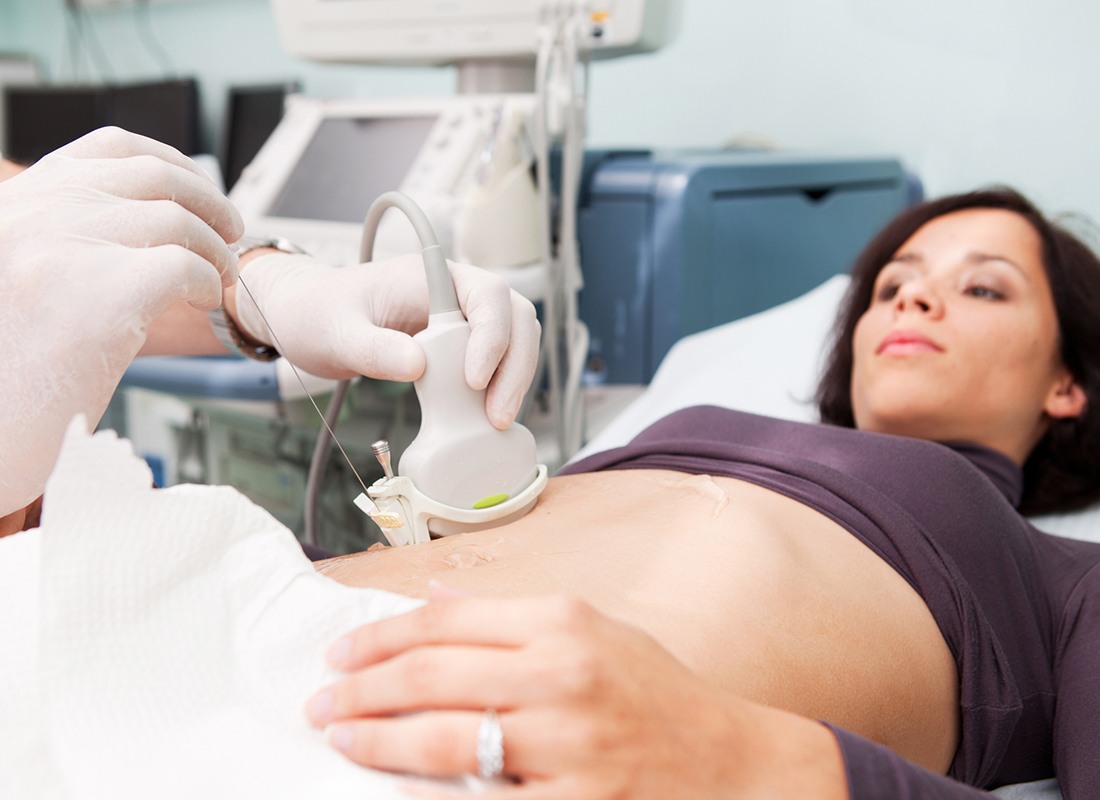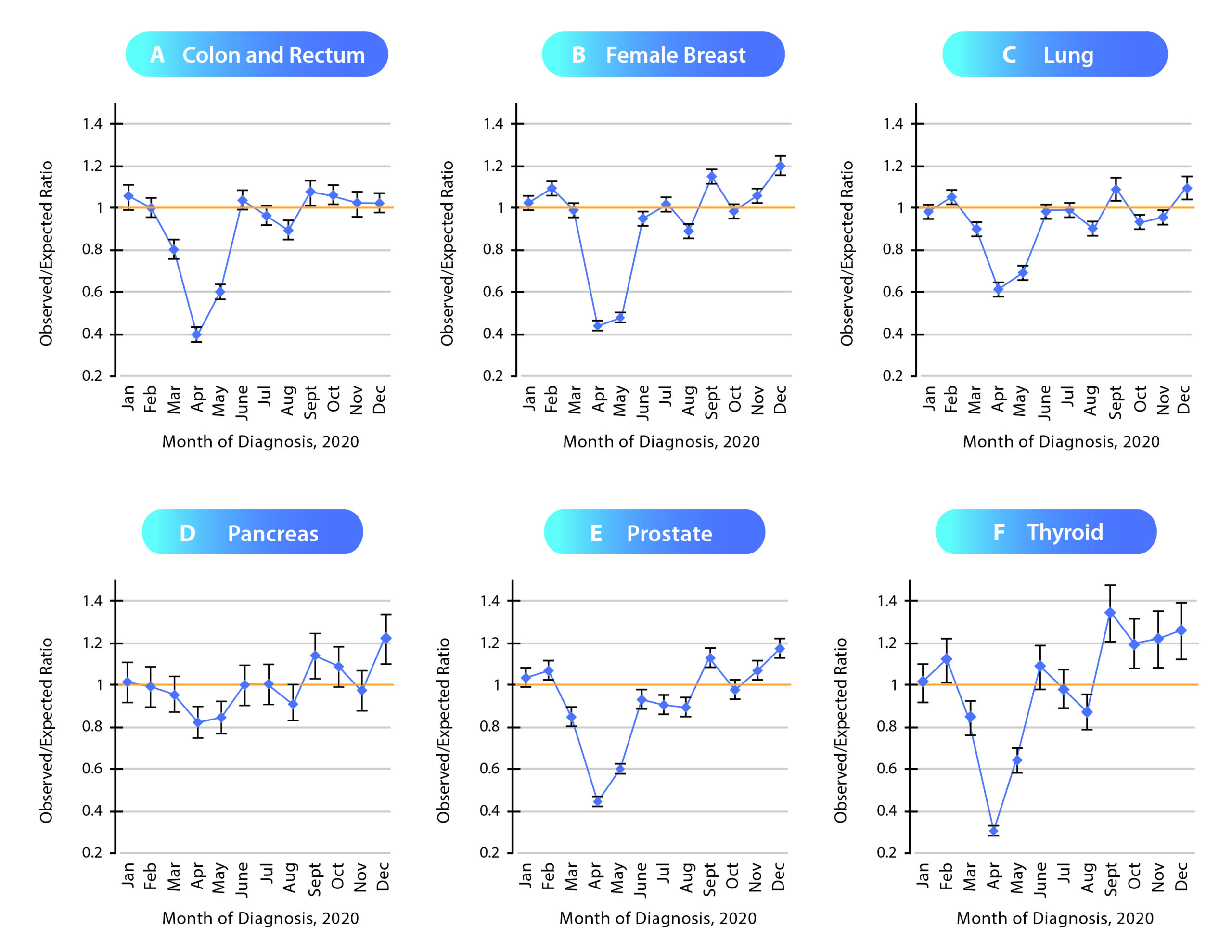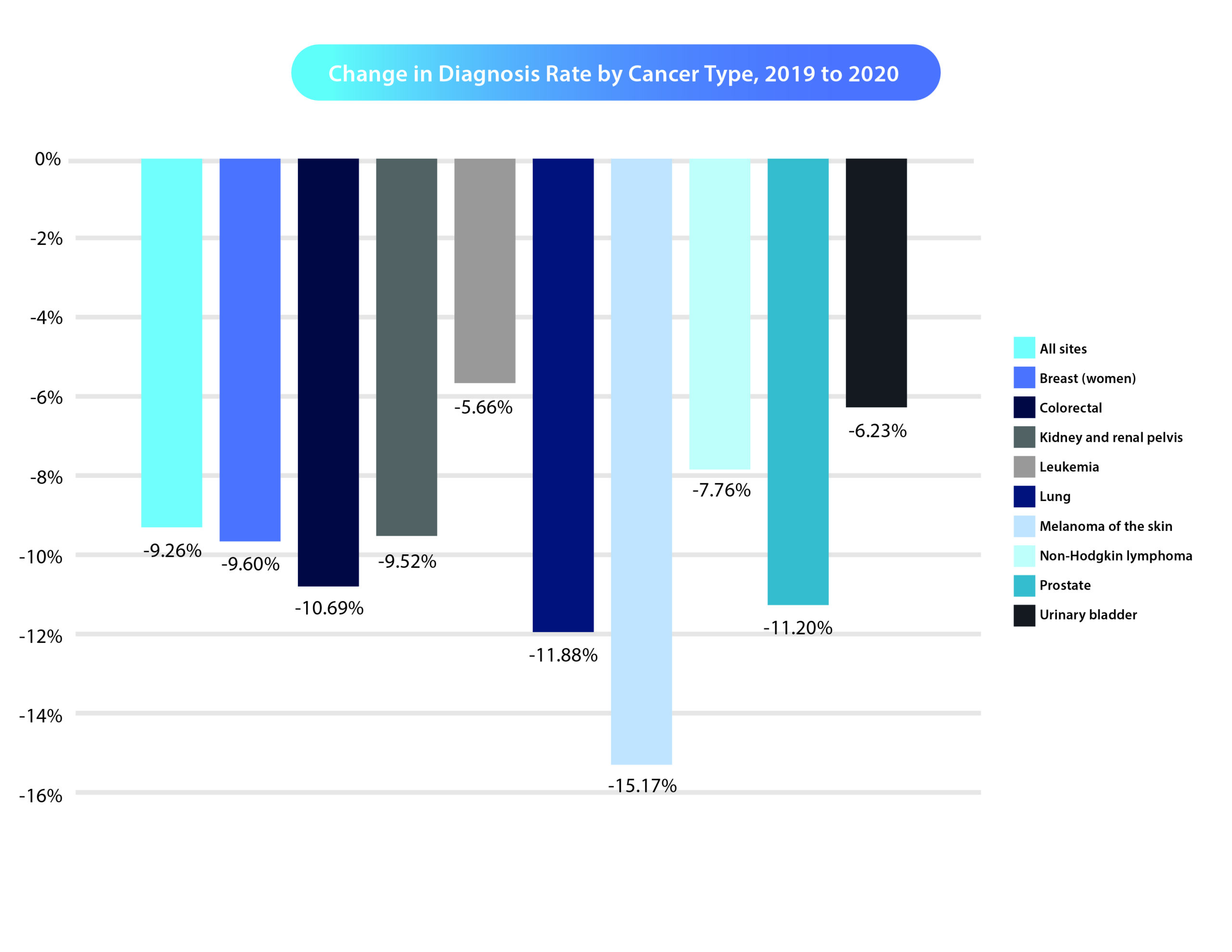Lost Ground: Cancer Screening in the COVID-19 Era
A pandemic-related drop in cancer diagnoses could spell long-term trouble for patients and providers.

Each year, four major health organizations—the American Cancer Society, the Centers for Disease Control and Prevention, the National Cancer Institute, and the North American Association of Central Cancer Registries—collaborate to release the Annual Report to the Nation on the Status of Cancer, an overview of trends, statistics, outcomes, and hot topics for the disease. This year’s report included good news on multiple fronts, with mortality rates on the decline over the past five years for 11 of the 19 most common cancers in men and 14 of the 20 most common in women.1 Overall death rates for male and female patients declined by 2.3 percent and 1.9 percent, respectively, along with decreases of 1.5 percent per year in children and 0.9 percent per year in young adults.
But not all of the news is good—with the COVID-19 pandemic came a drop in cancer diagnoses, which is likely to have knock-on effects on rates of treatment success, recurrence, and mortality. The 2023 report included a special focus on the pandemic’s effect on cancer diagnosis rates,2 comparing 2020’s predicted rates (based on trends from the preceding five years) with the year’s actual numbers. The result? A significant shortfall in diagnoses across six major primary cancer sites, with a corresponding decrease in relevant pathology report volume.3
The story in statistics
The six cancer sites examined in the report included colorectal, breast (in women only), lung, pancreas, prostate, and thyroid cancers. A month-by-month examination of the ratio of observed to expected diagnoses (O/E ratio) reveals that, although case rates were at or above expected levels through January and February of 2020, they experienced a rapid drop in March and especially April, only returning to approximately expected levels in the latter half of the year (see Figure 1).

The annual report also examined the numbers of pathology reports submitted to participating cancer registries, using an artificial intelligence (AI) algorithm to group reports by month of collection, primary tumor site, histology, and report type. The number of biopsy reports each month correlated closely with the absolute number of new diagnoses, showing a rapid drop in April 2020 and a return to near previous levels in the second half of the year. But despite this apparent recovery, overall new cancer diagnoses in 2020 remained significantly below expected rates in almost all primary sites—though thyroid cancer diagnosis in men and pancreatic cancer diagnosis in all genders ultimately fell within expected ranges for the year. Additional analysis revealed that incidence rates also fell for cancer types not examined in the report, such as leukemia, lymphoma, and melanoma (see Figure 2).

The report also broke down cancer diagnoses by stage at diagnosis, showing that the diagnosis rates for advanced cancers were closer to expected values than those for in situ and localized cases—likely a result of the reduction in screening procedures,6 in-person medical visits,7 nonessential surgeries,8 and investigations of minor or nonspecific symptoms9 during pandemic lockdowns.
Implications for the lab
A reduction in cancer diagnoses may spell trouble for patients and providers alike. “We are deeply concerned about the implications of delayed diagnosis, which is typically associated with more aggressive disease and worse outcomes,” American Cancer Society CEO Karen E. Knudsen, MBA, PhD, told journalists.10 “It is imperative to ensure that we make up for lost ground on finding cancers early and thereby maximize opportunities for effective treatment and survival.”
For labs, this has meant a rapid post-lockdown increase in the demand for services, especially those related to screening and early detection.11 With work-life balance stress and burnout prevalent even before the pandemic in all clinical laboratory professions,12–14 rising workloads and ongoing workforce shortages can threaten service provision and place throughput and turnaround time targets at risk. To address these issues, the American Society for Clinical Pathology proposed a blueprint for action that includes promoting laboratory careers, expanding and refining training and recruitment efforts, and increasing diversity and inclusivity in the clinical lab.15 Technology can also support laboratorians in coping with rising demand, with options ranging from remote reporting software to AI-based diagnostic support. As digital solutions become more widespread, gains in quality and efficiency may help offset the workload issues labs face.
The long-term outlook
Missed opportunities for early detection in 2020 and beyond may threaten recent progress against cancer and increase the number of late-stage diagnoses—a trend already emerging in lung,16 breast,17 and colorectal18 cancers. In addition, over half of patients already diagnosed had treatments missed or delayed during lockdowns;19 others hesitated to seek cancer-related care due to fear of contracting COVID-19.20 These disruptions to diagnosis and disease management have affected patients’ treatment options, raised the likelihood of adverse outcomes, and increased cancer-associated healthcare costs. The backlog may take years to clear21 and cause significant loss of life in the long term.22
But hope remains—in no small part thanks to laboratories. The rapid development and approval of novel vaccines during the pandemic has led to technological and regulatory advancements that could herald new approaches to cancer prevention and treatment. (In fact, the viral vector technology used to create the Oxford–AstraZeneca COVID-19 vaccine is now under investigation in cancer immunotherapy.23) Labs are working to reduce backlogs and alleviate delays in diagnosis and treatment, using new tools and techniques to decrease turnaround times and deliver personalized care. Combining innovations in cancer screening and detection with growing recruitment and training efforts could offer a path to recovery and restore previous gains made in cancer prevention, treatment, and survival.
References:
-
- Cronin KA et al. Annual report to the nation on the status of cancer, part 1: national cancer statistics. Cancer. 2022;128(24):4251–4284. doi:10.1002/cncr.34479.
-
- Surveillance, Epidemiology, and End Results Program. Annual Report to the Nation Special Topic: Early Assessment of the COVID-19 Pandemic’s Impact on Cancer Diagnosis. National Cancer Institute. https://seer.cancer.gov/report_to_nation/covid.html.
-
- Negoita S et al. Annual Report to the Nation on the Status of Cancer, part 2: early assessment of the COVID-19 pandemic’s impact on cancer diagnosis. Cancer. 2023; online ahead of print. doi:10.1002/cncr.35026.
-
- Surveillance, Epidemiology, and End Results Program. Annual Report to the Nation 2022: Shareable Resources. National Cancer Institute. https://seer.cancer.gov/data/covid-impact.html.
-
- Surveillance, Epidemiology, and End Results Program. Impact of COVID on 2020 SEER Cancer Incidence Data. National Cancer Institute. https://seer.cancer.gov/report_to_nation/materials.html.
-
- Kelkar AH et al. Impact of the COVID-19 pandemic on colorectal and prostate cancer screening in a large U.S. health system. Healthcare (Basel). 2022;10(2):264. doi:10.3390/healthcare10020264.
-
- London JW et al. Effects of the COVID-19 pandemic on cancer-related patient encounters. JCO Clin Cancer Inform. 2020;4:657–665. doi:10.1200/CCI.20.00068.
-
- Zheng NS et al. A retrospective approach to evaluating potential adverse outcomes associated with delay of procedures for cardiovascular and cancer-related diagnoses in the context of COVID-19. J Biomed Inform. 2021;113:103657. doi:10.1016/j.jbi.2020.103657.
-
- Moynihan R et al. Impact of COVID-19 pandemic on utilisation of healthcare services: a systematic review. BMJ Open. 2021;11(3):e045343. doi:10.1136/bmjopen-2020-045343.
-
- National Cancer Institute. Annual Report to the Nation Part 2: New cancer diagnoses fell abruptly early in the COVID-19 pandemic. September 27, 2023. https://www.cancer.gov/news-events/press-releases/2023/annual-report-to-the-nation-part-2-pandemic-cancer-diagnoses.
-
- Gatellier L et al. The impact of COVID-19 on cancer care in the post pandemic world: five major lessons learnt from challenges and countermeasures of major Asian cancer centres. Asian Pac J Cancer Prev. 2021;22(3): 681–690. doi:10.31557/APJCP.2021.22.3.681.
-
- Garcia E et al. The American Society for Clinical Pathology’s job satisfaction, well-being, and burnout survey of pathologists. Am J Clin Pathol. 2020;153(4):435–448. doi:10.1093/ajcp/aqaa010.
-
- Garcia E et al. The American Society for Clinical Pathology’s job satisfaction, well-being, and burnout survey of laboratory professionals. Am J Clin Pathol. 2020;153(4):470–486. doi:10.1093/ajcp/aqaa008.
-
- Kelly M et al. Job stress, burnout, work-life balance, well-being, and job satisfaction among pathology residents and fellows. Am J Clin Pathol. 2020;153(4):449–469. doi:10.1093/ajcp/aqaa013.
-
- Garcia E et al. The Clinical Laboratory Workforce: Understanding the Challenges to Meeting Current and Future Needs: Blueprint for Action. American Society for Clinical Pathology. https://ascpcdn.s3.amazonaws.com/static/ISTP/Siemens_Clinical+Laboratory+Workforce_Blueprint.pdf.
-
- Mynard N et al. Lung cancer stage shift as a result of COVID-19 lockdowns in New York City, a brief report. Clin Lung Cancer. 2022;23(3):e238–e242. doi:10.1016/j.cllc.2021.08.010.
-
- Lloyd MR et al. The impact of COVID-19 on breast cancer stage at diagnosis. J Clin Oncol. 2021;39(15):528. doi:10.1200/JCO.2021.39.15_suppl.528.
-
- Zhou JZ et al. Comparison of early- and late-stage breast and colorectal cancer diagnoses during vs before the COVID-19 pandemic. JAMA Netw Open. 2022;5(2):e2148581. doi:10.1001/jamanetworkopen.2021.48581.
-
- M Benzeval et al. Understanding Society COVID-19 Survey April Briefing Note: Health and Caring, Understanding Society Working Paper No 11/2020. https://www.understandingsociety.ac.uk/sites/default/files/downloads/general/ukhls_briefingnote_covid_health_final.pdf.
-
- Dhada S et al. Cancer services during the COVID-19 pandemic: systematic review of patient’s and caregiver’s experiences. Cancer Manag Res. 2021;13:5875–5887. doi:10.2147/CMAR.S318115.
-
- Iacobucci G. Cancer backlog could take till 2033 to clear without more consultants, says report. BMJ. 2021;374:n2352. doi:10.1136/bmj.n2352.
-
- Malagón T et al. Predicted long-term impact of COVID-19 pandemic-related care delays on cancer mortality in Canada. Int J Cancer. 2022;150(8):1244–1254. doi:10.1002/ijc.33884.
-
- McAuliffe J et al. Heterologous prime-boost vaccination targeting MAGE-type antigens promotes tumor T-cell infiltration and improves checkpoint blockade therapy. J Immunother Cancer. 2021;9(9):e003218. doi:10.1136/jitc-2021-003218.
Subscribe to Clinical Diagnostics Insider to view
Start a Free Trial for immediate access to this article